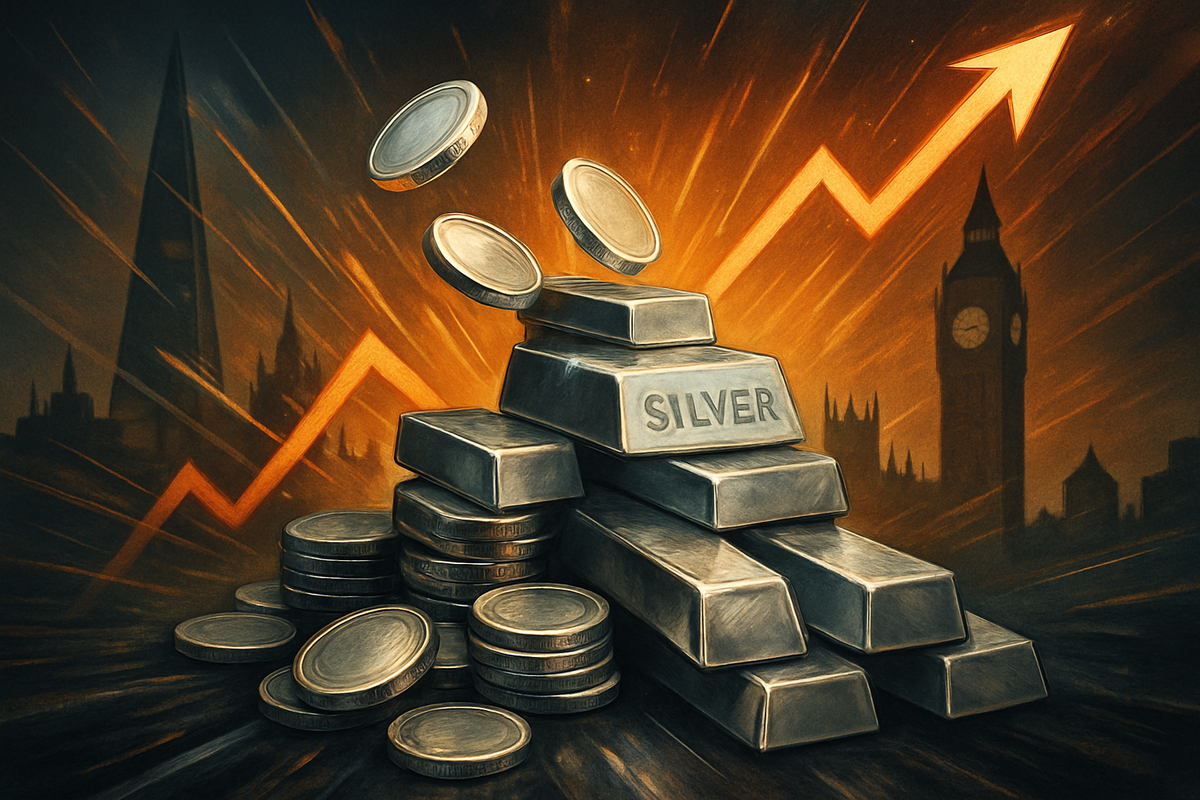
London's financial district is abuzz as a historic silver squeeze intensifies, propelling prices of the precious metal to multi-decade highs and creating significant turbulence in global markets. As of October 10, 2025, silver has become a standout performer in the commodities sector, with its value soaring past the $50 per ounce mark, a level not seen consistently since the speculative frenzy of 2011 and the legendary market cornering attempt of the Hunt brothers in 1980. This unprecedented surge is not merely a speculative bubble; it is underpinned by a confluence of robust physical demand, persistent supply deficits, and a strong influx of investment capital seeking refuge amidst an uncertain global economic landscape.
The immediate implications of this squeeze are profound and far-reaching. The cost of borrowing silver in London has reached astronomical levels, with annualized lease rates now hovering between 35-39%, a clear indicator of extreme scarcity in the physical market. An unusual and significant price disconnect has emerged between London spot prices and COMEX futures in New York, with London commanding a premium of $2.00 to over $2.50 per ounce. This inversion of the typical market dynamic underscores the acute physical tightness gripping London's bullion market, contrasting sharply with relatively more accessible inventories across the Atlantic. Furthermore, free-floating silver inventory in London's vaults is dwindling rapidly, with analysts projecting a potential exhaustion within months if current consumption rates persist, raising alarms across the industry.
Unprecedented Scarcity and Market Dislocation
The current historic silver squeeze in London is characterized by a confluence of factors that have created a perfect storm for price appreciation and market dislocation. The surge in silver prices, momentarily touching highs around $51.22 to $51.30 per ounce on October 9th and 10th, 2025, marks a significant milestone, with year-to-date gains exceeding 70%. This rally is fundamentally distinct from previous spikes, being rooted in a genuine and accelerating physical demand that is consistently outstripping available supply across multiple sectors.
The timeline leading to this moment has been building for years. The global silver market has faced structural deficits for five consecutive years, with projections for 2025 indicating yet another substantial shortfall. This persistent supply-demand imbalance forms the bedrock of the current squeeze. A significant event earlier in 2025 involved fears of potential U.S. tariffs on silver, which triggered a substantial relocation of the metal from London to New York. This movement further depleted London's readily available inventories, exacerbating the physical scarcity that is now so acutely felt. Key players in this evolving narrative include major bullion banks, industrial consumers, exchange-traded funds (ETFs) and their managers, and individual investors. The London Bullion Market Association (LBMA) and the COMEX exchange are central to the pricing and inventory dynamics, with their respective market structures highlighting the current disconnect. Initial market reactions have been characterized by heightened volatility, with analysts noting that silver's price swings are now approximately 1.7 times faster than gold's, creating both lucrative opportunities and significant risks for market participants. The suspension of new lump-sum investments in a silver ETF-of-fund product by an Indian asset management company due to global physical tightness further illustrates the far-reaching impact of London's predicament.
Companies Poised for Gains and Losses Amidst the Silver Surge
The historic silver squeeze and subsequent price surge are creating a distinct divide between potential winners and losers in the corporate landscape. Mining companies, particularly those with significant silver exposure, stand to benefit immensely from the elevated prices. Companies like Fresnillo PLC (LSE: FRES), a leading silver producer, and Pan American Silver Corp. (TSX: PAAS, NASDAQ: PAAS), with operations across the Americas, are likely seeing substantial boosts to their revenues and profitability. Higher silver prices directly translate into increased margins, potentially fueling expansion projects and shareholder returns. Other notable silver miners such as Wheaton Precious Metals Corp. (TSX: WPM, NYSE: WPM), a streaming and royalty company, also stand to gain as the value of their underlying assets and future streams appreciates significantly.
Conversely, industries heavily reliant on silver as a key input material face considerable challenges. Manufacturers of solar panels, electronics, and electric vehicles, which are significant consumers of industrial silver, will contend with escalating production costs. Companies like First Solar, Inc. (NASDAQ: FSLR), a major solar panel manufacturer, and various electronics giants, could see their profit margins squeezed if they cannot effectively pass on these increased costs to consumers. While silver's unique properties make it irreplaceable in many high-tech applications, the soaring prices could force these industries to explore cost-mitigation strategies, including redesigns or the development of more efficient silver usage. Furthermore, financial institutions with large short positions in silver or those involved in silver leasing could face significant losses due to the skyrocketing borrowing costs and the rapid appreciation of the metal.
The long-term implications for these companies will depend on their hedging strategies, operational efficiencies, and ability to adapt to a persistently high-priced silver market. Miners will likely accelerate exploration and production, while industrial users may seek to innovate for greater efficiency or explore alternative materials where possible, though silver's unique conductivity often limits viable substitutes.
Wider Significance and Historical Context
This historic silver squeeze transcends a mere price spike; it represents a significant inflection point within broader industry trends and carries substantial wider significance. The event underscores the accelerating demand for silver driven by the global "green energy revolution." Silver is an indispensable component in solar panels, electric vehicles, and a vast array of advanced electronics due to its unparalleled electrical conductivity. As the world transitions towards renewable energy and electrification, industrial demand for silver is exploding, fundamentally altering the metal's supply-demand dynamics. This trend suggests that the current squeeze is not a fleeting speculative event but rather a symptom of a deeper structural shift where supply struggles to keep pace with an increasingly electrified global economy.
The ripple effects extend to competitors and partners across the commodities and technology sectors. Gold, often seen as silver's precious metal counterpart, is also benefiting from safe-haven flows, but silver's industrial demand component gives it a distinct advantage in the current climate. Regulatory bodies and policymakers will be closely monitoring the market volatility and potential for manipulation, especially given the historical precedents. Comparisons are inevitably drawn to the 1980 Hunt brothers' attempt to corner the silver market and the 2011 rally. However, the current squeeze differs significantly in its underlying drivers, which are rooted in genuine physical demand and structural deficits rather than purely speculative financial plays. This distinction may influence any potential regulatory responses, which could range from increased scrutiny of trading practices to discussions around strategic reserves or incentives for increased mining output. The ongoing strength of the U.S. dollar, coupled with global geopolitical uncertainties, further amplifies silver's appeal as a tangible asset and a hedge against inflation and economic instability, reinforcing its role beyond mere industrial utility.
The Road Ahead: Navigating a Tight Silver Market
Looking ahead, the historic silver squeeze in London portends a period of sustained volatility and strategic re-evaluation for all market participants. In the short term, prices are likely to remain elevated, supported by the ongoing physical scarcity and robust demand. The significant premium of London spot prices over COMEX futures indicates that the physical tightness is unlikely to abate quickly. This could lead to continued high borrowing costs for silver and further depletion of readily available inventories. Market opportunities may emerge for agile investors and institutions capable of navigating extreme price swings, potentially through strategic physical acquisitions or carefully constructed long positions. However, the risks of sharp corrections due to profit-taking or sudden shifts in market sentiment also remain considerable.
In the long term, the dynamics of the silver market will hinge on several critical factors. Mining companies will likely accelerate investment in exploration and production to capitalize on higher prices, but new supply typically takes years to come online. This means structural deficits could persist for the foreseeable future. Industrial consumers will face increasing pressure to innovate and optimize silver usage, or potentially seek out alternative materials where feasible, though silver's unique properties often make substitution difficult. Strategic pivots may include greater emphasis on recycling silver from electronic waste. Potential scenarios range from a gradual easing of the squeeze as new supply comes online and industrial efficiency improves, to a more prolonged period of elevated prices if demand continues to outstrip supply growth. Investors should watch for changes in global economic growth forecasts, the pace of green energy adoption, and any regulatory interventions that might impact supply or demand dynamics. The ongoing strength of safe-haven demand, particularly in light of global fiscal pressures and currency fluctuations, will also be a key determinant of silver's trajectory.
A New Era for Silver: Enduring Impact and Investor Outlook
The historic silver squeeze deepening in the London market marks a pivotal moment for the precious metal, underscoring its dual role as both an indispensable industrial commodity and a crucial safe-haven asset. The key takeaway from this event is that the current surge in prices is not merely a speculative phenomenon but is deeply rooted in fundamental supply-demand imbalances, particularly the burgeoning industrial demand driven by the global green energy transition. The acute physical tightness, record borrowing costs, and the significant London-COMEX price disconnect are all symptoms of a market under immense pressure, signaling a potential paradigm shift in silver's valuation.
Moving forward, the silver market is likely to remain highly dynamic and subject to significant volatility. Investors should prepare for a landscape where silver's price movements could be more pronounced than historical averages, potentially outpacing gold's volatility. The lasting impact of this squeeze will likely be a heightened awareness of silver's strategic importance in the modern economy, particularly as electrification and renewable energy initiatives accelerate. This could lead to greater investment in silver mining and recycling technologies, alongside increased innovation in industrial applications to optimize its use.
For investors, the coming months will require careful observation. Key indicators to watch include the trajectory of global industrial output, particularly in the solar and EV sectors, updates on mining supply and new discoveries, and any shifts in central bank monetary policies or geopolitical stability that might influence safe-haven demand. While the current environment presents compelling opportunities for those with a high risk tolerance, it also necessitates a thorough understanding of market fundamentals and the potential for sharp reversals. The historic silver squeeze is not just a financial headline; it is a powerful indicator of evolving global economic and industrial priorities, positioning silver at the forefront of the commodities market for the foreseeable future.
This content is intended for informational purposes only and is not financial advice






